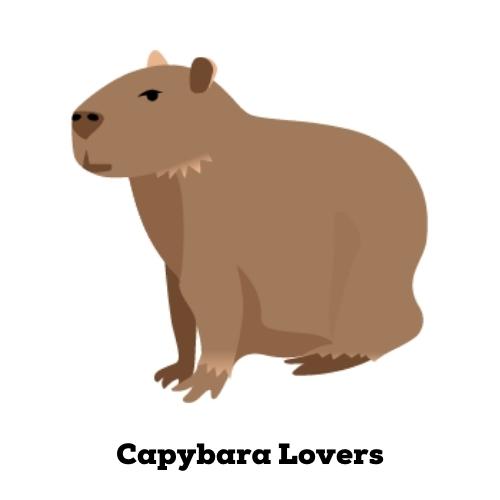Capybaras are South American rodents found in the grasslands of South America.
They spend much of their time in rivers and lakes or swamps or marshes.
These semi-aquatic animals capture prey with a snout that resembles a giant catfish and a long, flexible neck.
Capybaras have thick fur and keep warm by huddling together under wet sheets of skin; they also cool down by soaking in water.
They are omnivores that eat both plants and animals. A capybara’s diet mainly consists of plant matter but it also eats small amounts of fish, insects, birds’ eggs, frogs, lizards, fruits, and seeds.
Capybaras are solitary except during breeding season when several males may live together to protect females and raise their young in a large communal nursery called a jacuzzi.
Under ideal conditions, capybaras can breed once every two years although they may mate every day during this period.
After mating the female capybara will dig her shallow burrow to give birth to her young in solitude.
Like most rodents, capybaras have an extended gestation period of about five months after which two offspring emerge from the mother’s womb almost fully developed at about 3 weeks old.
The youngsters remain with their mother for another 6-8 months until they are big enough to Defend themselves as adults again. During this time both parents tend to them and help them learn how to forage for food.
The diet of young capybaras primarily consists of plants and grasses but they may also eat small invertebrates such as insects, worms, and snails.
Once the youngsters are old enough to fend for themselves, their diet changes to a more omnivorous one that includes whatever is available in their habitat: fruits, leaves, stems, aquatic plants, grasses, small rodents, and fish. They even feed on tree bark when necessary.
The mature adult capybara can consume up to 8 kg (17 lbs) of vegetation per day which makes it an important part of the local ecology by controlling plant overgrowth in some areas.
In captivity, capybaras will eat most vegetables, fruits, and grains as well as dog or cat food. This may include hay, carrots, apples, bananas, sweet potatoes, celery, and other fruits and vegetables. They should also be given access to fresh water at all times.
Capybaras are highly social creatures that enjoy being handled by humans but they can also become stressed if not provided sufficient space and companionship.
Therefore owners need to provide a large enough enclosure with plenty of hiding places for their capybara pet.
Providing sufficient environmental enrichment will help keep them happy and healthy throughout the years.
In addition to the proper diet, caretakers must ensure the enclosure has adequate humidity (50-80%), lighting (filtered sunlight or artificial light), and heating (room temperature).
These factors are critical as too little of either can lead to poor health.
Providing plenty of hiding places for the capybara is also essential since they like to hide during daylight hours and come out at night to feed.
Finally, it’s important to remember that these animals are social creatures and should not be kept in solitary confinement.
Keeping two or more together in a large enclosure can help reduce stress levels and encourage healthy behaviors, such as grooming each other. With proper care, diet, and environmental enrichment, a capybara can be an incredibly rewarding pet that brings joy for many years to come!
How often do capybaras eat?
Capybaras are mainly herbivores. They mainly eat plant material, some of which is semi-digested and passed through their system as a type of fiber that can be deposited in patches on the ground to provide food for other animals, such as termites, ants, or worms.
When capybaras encounter an abundance of food, they will gorge themselves without any digestion or waste.
This practice can result in overpopulation if the population density is too high for the area’s carrying capacity. When a capybara is full it will fall asleep with its belly flat on the ground.
Capybaras also have a unique way of sleeping called “nap sitting” where they sleep with their head balanced on top of their body and all four feet pointing in one direction on top of each other.
The best time to spot these sleepy critters is early morning when they are still dozing off after a long night’s sleep.
What capybaras cannot eat?
Despite their omnivorous diet, there are some foods that capybaras should not eat. These include chocolate and other sweets, processed human food (e.g., chips), avocados, onions, garlic, and any nut or seed.
Eating these foods can lead to digestive problems and even death in some cases as they cannot digest them properly.
It is also important to only provide fresh fruits and vegetables for your pet as spoiled food can cause serious health issues. Finally, it’s important to avoid feeding your capybara dog or cat food as this can also upset their digestion.
Overall, the best diet for a capybara consists of hay, grasses, leaves, stems, and roots.
Conclusion
owning a capybara as a pet can be an incredibly rewarding experience.
It’s important to remember that these animals require special care and attention to keep them safe and healthy.
This includes providing the proper diet, adequate humidity levels, and plenty of lighting, and heating in the enclosure.
Additionally, it is essential to provide environmental enrichment such as hiding places or companionship if kept singly; this will help reduce stress levels and encourage natural behaviors such as grooming each other.
Good Luck.














